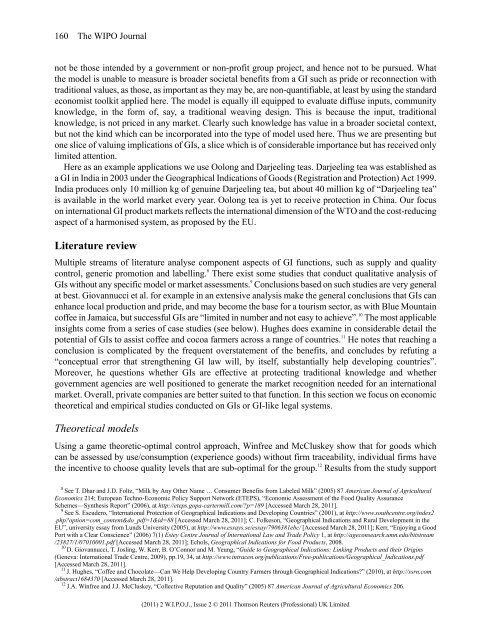WIPO Journal - World Intellectual Property Organization
WIPO Journal - World Intellectual Property Organization
WIPO Journal - World Intellectual Property Organization
Create successful ePaper yourself
Turn your PDF publications into a flip-book with our unique Google optimized e-Paper software.
160 The <strong>WIPO</strong> <strong>Journal</strong><br />
not be those intended by a government or non-profit group project, and hence not to be pursued. What<br />
the model is unable to measure is broader societal benefits from a GI such as pride or reconnection with<br />
traditional values, as those, as important as they may be, are non-quantifiable, at least by using the standard<br />
economist toolkit applied here. The model is equally ill equipped to evaluate diffuse inputs, community<br />
knowledge, in the form of, say, a traditional weaving design. This is because the input, traditional<br />
knowledge, is not priced in any market. Clearly such knowledge has value in a broader societal context,<br />
but not the kind which can be incorporated into the type of model used here. Thus we are presenting but<br />
one slice of valuing implications of GIs, a slice which is of considerable importance but has received only<br />
limited attention.<br />
Here as an example applications we use Oolong and Darjeeling teas. Darjeeling tea was established as<br />
a GI in India in 2003 under the Geographical Indications of Goods (Registration and Protection) Act 1999.<br />
India produces only 10 million kg of genuine Darjeeling tea, but about 40 million kg of “Darjeeling tea”<br />
is available in the world market every year. Oolong tea is yet to receive protection in China. Our focus<br />
on international GI product markets reflects the international dimension of the WTO and the cost-reducing<br />
aspect of a harmonised system, as proposed by the EU.<br />
Literature review<br />
Multiple streams of literature analyse component aspects of GI functions, such as supply and quality<br />
control, generic promotion and labelling. 8 There exist some studies that conduct qualitative analysis of<br />
GIs without any specific model or market assessments. 9 Conclusions based on such studies are very general<br />
at best. Giovannucci et al. for example in an extensive analysis make the general conclusions that GIs can<br />
enhance local production and pride, and may become the base for a tourism sector, as with Blue Mountain<br />
coffee in Jamaica, but successful GIs are “limited in number and not easy to achieve”. 10 The most applicable<br />
insights come from a series of case studies (see below). Hughes does examine in considerable detail the<br />
potential of GIs to assist coffee and cocoa farmers across a range of countries. 11 He notes that reaching a<br />
conclusion is complicated by the frequent overstatement of the benefits, and concludes by refuting a<br />
“conceptual error that strengthening GI law will, by itself, substantially help developing countries”.<br />
Moreover, he questions whether GIs are effective at protecting traditional knowledge and whether<br />
government agencies are well positioned to generate the market recognition needed for an international<br />
market. Overall, private companies are better suited to that function. In this section we focus on economic<br />
theoretical and empirical studies conducted on GIs or GI-like legal systems.<br />
Theoretical models<br />
Using a game theoretic-optimal control approach, Winfree and McCluskey show that for goods which<br />
can be assessed by use/consumption (experience goods) without firm traceability, individual firms have<br />
the incentive to choose quality levels that are sub-optimal for the group. 12 Results from the study support<br />
8<br />
See T. Dhar and J.D. Foltz, “Milk by Any Other Name … Consumer Benefits from Labeled Milk” (2005) 87 American <strong>Journal</strong> of Agricultural<br />
Economics 214; European Techno-Economic Policy Support Network (ETEPS), “Economic Assessment of the Food Quality Assurance<br />
Schemes—Synthesis Report” (2006), at http://eteps.gopa-cartermill.com/?p=189 [Accessed March 28, 2011].<br />
9<br />
See S. Escudero, “International Protection of Geographical Indications and Developing Countries” (2001), at http://www.southcentre.org/index2<br />
.php?option=com_content&do_pdf=1&id=88 [Accessed March 28, 2011]; C. Folkeson, “Geographical Indications and Rural Development in the<br />
EU”, university essay from Lunds University (2005), at http://www.essays.se/essay/7906381ebc/ [Accessed March 28, 2011]; Kerr, “Enjoying a Good<br />
Port with a Clear Conscience” (2006) 7(1) Estey Centre <strong>Journal</strong> of International Law and Trade Policy 1, at http://ageconsearch.umn.edu/bitstream<br />
/23827/1/07010001.pdf [Accessed March 28, 2011]; Echols, Geographical Indications for Food Products, 2008.<br />
10<br />
D. Giovannucci, T. Josling, W. Kerr, B. O’Connor and M. Yeung, “Guide to Geographical Indications: Linking Products and their Origins<br />
(Geneva: International Trade Centre, 2009), pp.19, 34, at http://www.intracen.org/publications/Free-publications/Geographical_Indications.pdf<br />
[Accessed March 28, 2011].<br />
11<br />
J. Hughes, “Coffee and Chocolate—Can We Help Developing Country Farmers through Geographical Indications?” (2010), at http://ssrn.com<br />
/abstract1684370 [Accessed March 28, 2011].<br />
12<br />
J.A. Winfree and J.J. McCluskey, “Collective Reputation and Quality” (2005) 87 American <strong>Journal</strong> of Agricultural Economics 206.<br />
(2011) 2 W.I.P.O.J., Issue 2 © 2011 Thomson Reuters (Professional) UK Limited

















